Dermoloma cuneifolium (Fr.) Bon - Crazed Cap
Phylum: Basidiomycota - Class: Agaricomycetes - Order: Agaricales - Family: Tricholomataceae
Distribution - Taxonomic History - Etymology - Identification - Culinary Notes - Reference Sources
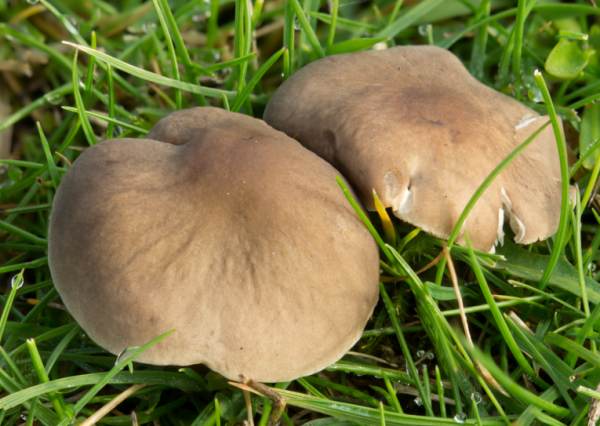
Most Dermoloma mushrooms are rare finds in Britain, but Dermoloma cuneifolium is an exception, being at least an occasional find in those regions where there is still plenty of unimproved grassland.
Distribution
This rather fragile mushroom can is found occasionally throughout Britain and Ireland. It also occurs, albeit infrequently, in many mainland European countries as well as in the Americas.
Taxonomic history
When the great Swedish mycologist Elias Magnus Fries described this mushroom in 1818, he gave it the scientific name Agaricus cuneifolius. Its currently-accepted name Dermoloma cuneifolium dates from a 1986 publication by French mycologist Marcel Bon.
Synonyms of Dermoloma cuneifolium include Agaricus cinereorimosus Batsch, Agaricus atrocinereus Pers., Agaricus cuneifolius Fr., and Tricholoma cuneifolium (Fr.) P. Kumm.
Dermoloma cuneifolium is the type species of its sparsely-populated genus. Two varieties of this species have been recorded: the autonomous Dermoloma cuneifolium var. cuneifolium (Fr.) Bon, and the more recently described Dermoloma cuneifolium var. punctipes Arnolds.
Etymology
Dermoloma, the genus name, comes from Derma- meaning a skin, and -loma meaning a fringe or hem. It is a reference to the way the pileipellis (the topmost layer of hyphae that make up the pileus or cap skin) of mushrooms in this group overhangs the margin of the cap.
The specific epithet cuneifolium means literally 'with leaves tapered to the base', and in the context of this particular mushroom it refers to the way that the gills are stepped sharply so that they reduce in width towards the stem.
Identification guide
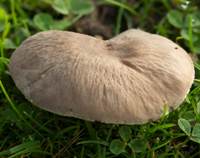 |
CapInitially conical or convex, later broadly convex or flattened, sometimes with a low umbo, or occasionally with a shallow depression; light brown to grey-brown; surface wrinkled radially; 1 to 6cm across when fully mature often cracking into irregular patches mainly concentrated towards the centre.. |
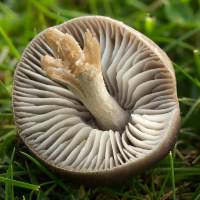 |
GillsBrittle; pale grey; moderately distant, sinuate-adnate to emarginate. StemWhitish or pale grey, with fine longitudinal fibrils; cylindrical or slightly tapering towards base; 1.8 to 6.5cm long, 0.2 to 1cm diameter; no stem ring. |
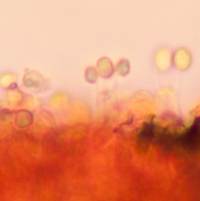 |
BasidiaClavate to narrowly clavate, 17-36 x 4.5-8μm. Usually the majority of the basidia are 4-spored with some 2-spored (see left) and occasionally 1- or 3-spored. CystidiaAbsent. |
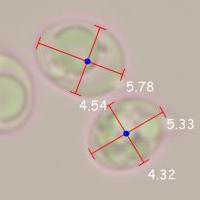 |
SporesEllipsoidal to broadly ellipsoidal, smooth, 4.5-7 x 3-5μm; inamyloid. (The latter is a very useful identifying character, because the other Dermoloma species that are recorded in Britain have amyloid spores.) Spore printWhite. |
Odour/taste |
Strong mealy odour and taste. |
Habitat & Ecological role |
Saprobic, in unimproved or very lightly fertilised grassland; occurring either singly or in small groups. |
Season |
Throughout summer and autumn in Britain and Ireland. |
Similar species |
Dermoloma josserandii appears in similar habitats; its gills are usually slightly decurrent and it has a more granular cap surface; its spores are amyloid. Some of the Cavaliers such as Melanoleuca polioleuca look rather like Dermoloma mushrooms but they do not usually have crazed caps and they also differ in having finely-warty spores rather than smooth spores. |
Culinary Notes
Dermoloma mushrooms are generally considered to be inedible. They are rare and it is unclear whether any of them contains toxins; they should therefore not be collected for human consumption. .
Reference Sources
Flora Agaricina Neerlandica: Critical Monographs of Families of Agarics and Boleti occuring in the Netherlands Vol. 3, Tricholomataceae (Ed.: C.Bas, Th.W. Kuyper, M.E. Noordeloos & E.C. Vellinga).
British Mycological Society, English Names for Fungi.
Dictionary of the Fungi; Paul M. Kirk, Paul F. Cannon, David W. Minter and J. A. Stalpers; CABI, 2008
Taxonomic history and synonym information on these pages is drawn from many sources but in particular from the British Mycological Society's GB Checklist of Fungi.
Acknowledgements
This page includes pictures kindly contributed by David Kelly.
Fascinated by Fungi. Back by popular demand, Pat O'Reilly's best-selling 450-page hardback book is available now. The latest second edition was republished with a sparkling new cover design in September 2022 by Coch-y-Bonddu Books. Full details and copies are available from the publisher's online bookshop...

